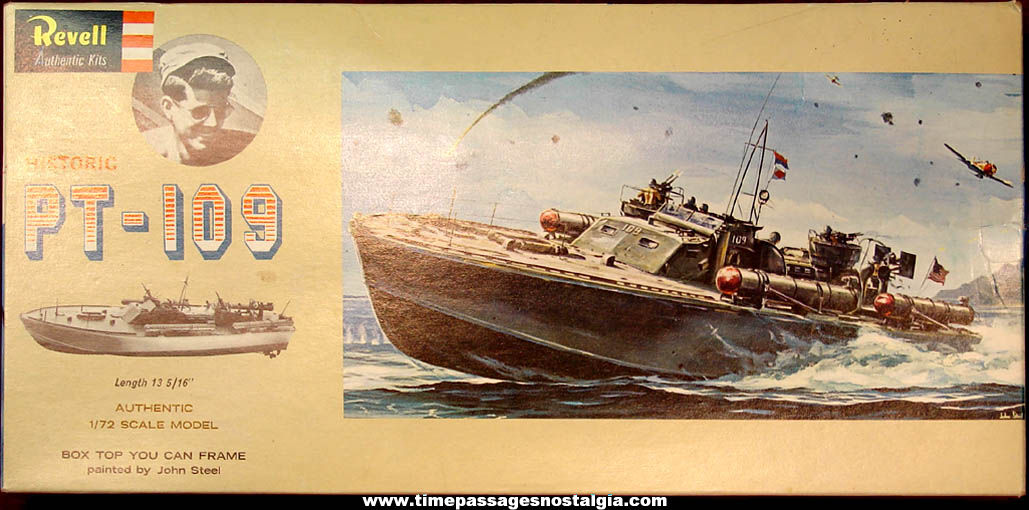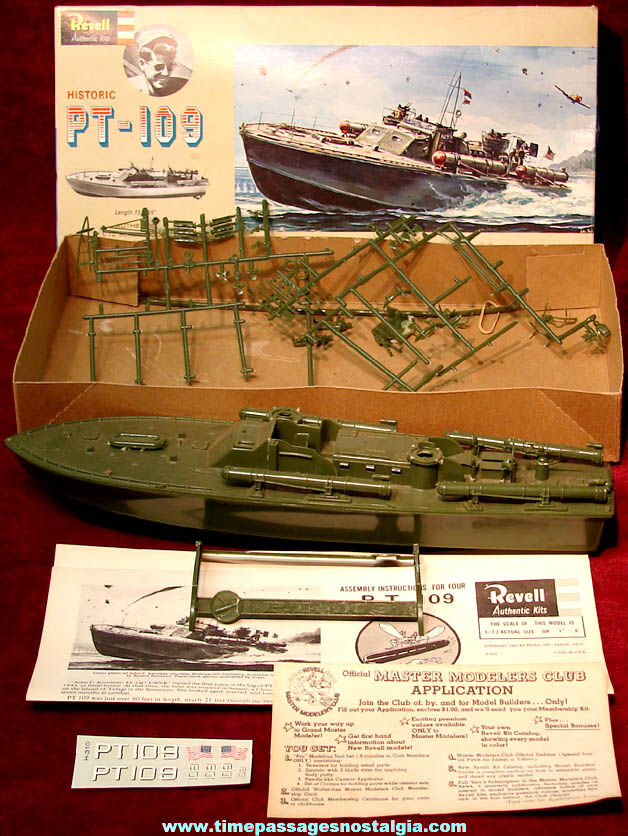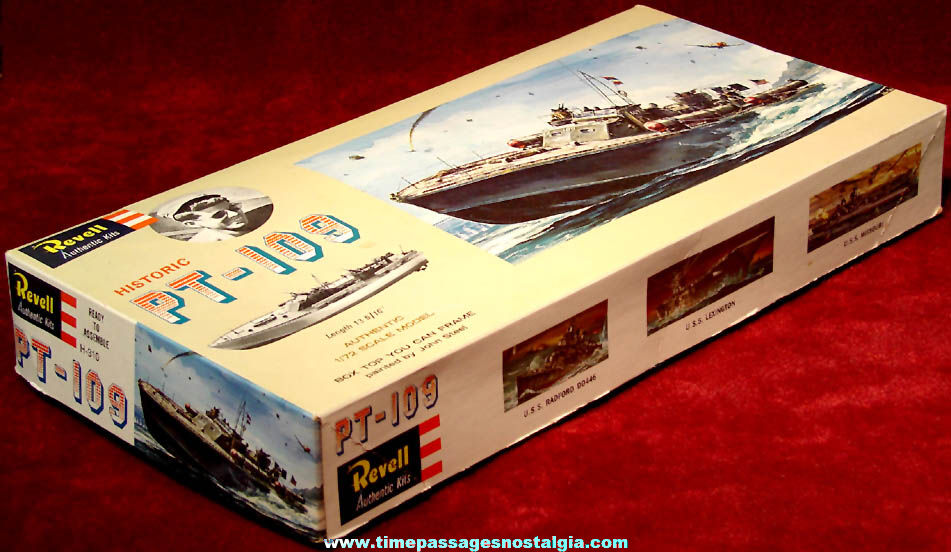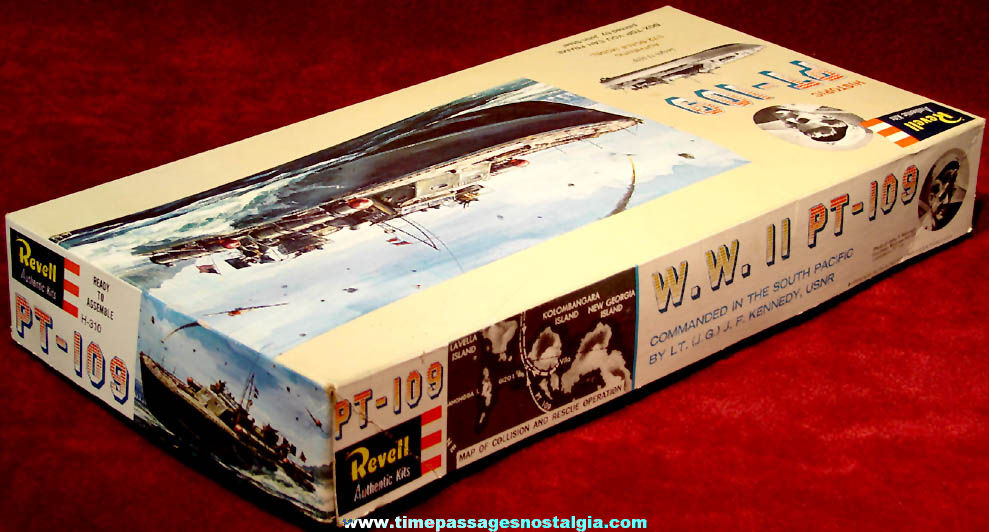
 | Item #o561 | 
Price: $19.99
$11 shipping & handling
For Sale
|
|
  | | Any group of items being offered as a lot must be sold as a lot. | | | Nostalgic Memorabilia, Pop Culture Artifacts, Historic Items,
and "Shoe Box Toys" | Quality Packing And
Postal Insurance | | An Ever Changing Inventory | | Unique & Fun Nostalgic Items | | Fast Dependable Service | | Quality Merchandise At Reasonable Prices | You don't have to be an eight year old to enjoy having
a childhood treasure. | Great memories
make great gifts! |
| | | | The pictures below show larger views of this Boxed ©1963 United States Navy Motor Torpedo PT-109 Revell Plastic Patrol Boat Model Kit. This is the U.S. Navy Torpedo Boat that was made famous by future U.S. President John F. Kennedy who served onboard. This model comes complete with instructions, decal sheet, and an application form to join the Official Revell Master Modelers Club. This is a plastic scale model kit by Revell. It is #H310. The box cover pictures (4) colorful images of the PT-109, (2) images of John F. Kennedy, and a map of the collision and recue operation. One side pictures other Revell model kits in color including the U.S.S. Radford DD-446 the U.S.S. Lexington CV-16, and the U.S.S. Missouri BB-63. The kit is opened, has some of the parts off of the sprues, and the model kit has been started, but appears to be complete. To judge the sizes the box measures about 13-3/4'' x 6-1/4'' x 1-7/8''. The kit appears to be in excellent condition as pictured. Below here, for reference, is some Historical information about the Motor Torpedo Boat PT-109 and U.S President John F. Kennedy: Motor Torpedo Boat PT-109
From Wikipedia, the free encyclopedia History
Name: PT-109
Ordered: 1942
Builder: Elco, Bayonne, New Jersey
Laid down: 4 March 1942
Launched: 20 June 1942
Completed: 19 July 1942
Identification: Hull symbol: PT-109
Motto: They were expendable.
Fate: Sunk by Japanese destroyer Amagiri, 2 August 1943
General characteristics
Displacement: 56 long tons (57 t) (full load)
Length: 80 feet (24 m) overall
Beam: 20 feet 8 inches (6.30 m)
Draft: 3 feet 6 inches (1.07 m) maximum (aft)
Installed power: 4,500 horsepower (3,400 kW)
Propulsion: 3 – 12 cylinder Packard W-14 M2500 gasoline engines, 3 shafts
Speed: 41 knots (76 km/h; 47 mph) maximum (trials)
Endurance: 12 hours, 6 hours at top speed
Complement: 3 officers, 14 enlisted men (design)
Armament: 4 – 21 inch (533 mm) torpedo tubes (four Mark 8 torpedoes), 1 – 20 millimeter (0.79 in) cannon aft, 2 twin .50 inch (12.7 mm) Browning M2 machine guns, 1 – 37 millimeter (1.5 in) cannon mounted forward (a field modification)
Armor: gunboat deck house protected against rifle bullets and splinter, some crews fitted armor plate to refrigerators The PT-109 was a PT boat (patrol torpedo boat) last commanded by Lieutenant (junior grade) John F. Kennedy, future United States President, in the Pacific Theater during World War II. His actions to save his surviving crew after the sinking of PT-109 made him a war hero. The PT-109’s collision contributed to Kennedy’s long term back problems and required months of hospitalization at Chelsea Naval Hospital. Kennedy’s post war campaigns for elected office referred often to his service on the PT-109. John F. Kennedy
From Wikipedia, the free encyclopedia 35th President of the United States
In office: January 20, 1961 - November 22, 1963
Vice President: Lyndon B. Johnson
Preceded by: Dwight D. Eisenhower
Succeeded by: Lyndon B. Johnson
United States Senator from Massachusetts
In office: January 3, 1953 - December 22, 1960
Preceded by: Henry Cabot Lodge Jr.
Succeeded by: Benjamin A. Smith II
Member of the U.S. House of Representatives from Massachusetts’s 11th district
In office: January 3, 1947 – January 3, 1953
Preceded by: James Michael Curley
Succeeded by: Tip O’Neill
Personal details
Born: John Fitzgerald Kennedy on May 29, 1917 in Brookline, Massachusetts, United States
Died: November 22, 1963 (aged 46) in Dallas, Texas, United States
Cause of death: Assassination (gunshot wound to the head)
Resting place: Arlington National Cemetery
Political party: Democratic
Spouse: Jacqueline Bouvier (m. 1953)
Children: Arabella, Caroline, John Jr., Patrick
Parents: Joseph P. Kennedy Sr.& Rose Fitzgerald
Education: Harvard University (AB)
Military service
Allegiance: United States
Branch / Service: United States Navy
Years of service: 1941 - 1945
Rank: U.S. Navy O3 Lieutenant
Unit: Motor Torpedo Squadron 2, Patrol Torpedo Boat 109, Patrol Torpedo Boat 59
Battles / Wars: World War II, Solomon Islands campaign
Awards: Navy and Marine Corps Medal, Purple Heart, American Defense Service Medal,
American Campaign Medal, Asiatic-Pacific Campaign Medal (with 3 service stars), World War II Victory Medal John Fitzgerald Kennedy (May 29, 1917 - November 22, 1963), often referred to by his initials JFK, was an American politician who served as the 35th president of the United States from 1961 until his assassination in 1963. Kennedy served at the height of the Cold War, and the majority of his work as president concerned relations with the Soviet Union and Cuba. A Democrat, Kennedy represented Massachusetts in both houses of the U.S. Congress prior to becoming president. Kennedy was born into a wealthy, political family in Brookline, Massachusetts. He graduated from Harvard University in 1940, before joining the United States Naval Reserve the following year. During World War II, he commanded a series of PT boats in the Pacific theater and earned the Navy and Marine Corps Medal for his service. After a brief stint in journalism, Kennedy represented a working class Boston district in the U.S. House of Representatives from 1947 to 1953. He was subsequently elected to the U.S. Senate and served as the junior senator for Massachusetts from 1953 to 1960. While in the Senate, Kennedy published his book, Profiles in Courage, which won a Pulitzer Prize. In the 1960 presidential election, he narrowly defeated Republican opponent Richard Nixon, who was the incumbent vice president. Kennedy’s humor, charm, and youth in addition to his father’s money and contacts were great assets in the campaign. Kennedy’s campaign gained momentum after the first televised presidential debates in American history. Kennedy was the first Catholic elected president. Kennedy’s administration included high tensions with communist states in the Cold War. As a result, he increased the number of American military advisers in South Vietnam. The Strategic Hamlet Program began in Vietnam during his presidency. In April 1961, he authorized an attempt to overthrow the Cuban government of Fidel Castro in the failed Bay of Pigs Invasion. Kennedy authorized the Cuban Project in November 1961. He rejected Operation Northwoods (plans for false flag attacks to gain approval for a war against Cuba) in March 1962. However, his administration continued to plan for an invasion of Cuba in the summer of 1962. The following October, U.S. spy planes discovered Soviet missile bases had been deployed in Cuba; the resulting period of tensions, termed the Cuban Missile Crisis, nearly resulted in the breakout of a global thermonuclear conflict. He also signed the first nuclear weapons treaty in October 1963. Kennedy presided over the establishment of the Peace Corps, Alliance for Progress with Latin America, and the continuation of the Apollo space program with the goal of landing a man on the Moon. He also supported the civil rights movement, but was only somewhat successful in passing his New Frontier domestic policies. On November 22, 1963, he was assassinated in Dallas. Vice President Lyndon B. Johnson assumed the presidency upon Kennedy’s death. Marxist and former U.S. Marine Lee Harvey Oswald was arrested for the state crime, but he was shot and killed by Jack Ruby two days later. The FBI and the Warren Commission both concluded Oswald had acted alone in the assassination, but various groups contested the Warren Report and believed that Kennedy was the victim of a conspiracy. After Kennedy’s death, Congress enacted many of his proposals, including the Civil Rights Act and the Revenue Act of 1964. Despite his truncated presidency, Kennedy ranks highly in polls of U.S. presidents with historians and the general public. His personal life has also been the focus of considerable sustained interest following public revelations in the 1970s of his chronic health ailments and extramarital affairs. Kennedy was the last U.S. President to have been assassinated as well as the last U.S. president to die in office. |
|
Click on image to zoom.
    |